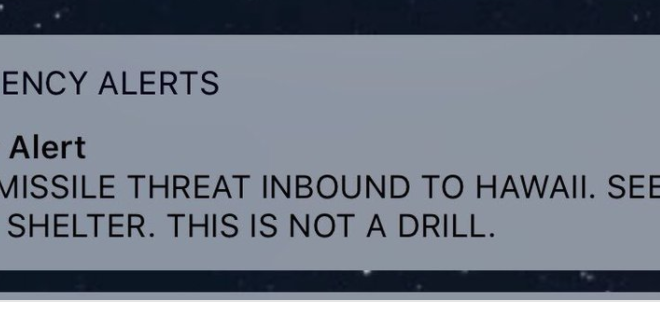Imagine watching the palm trees sway, listening to the waves crash and then suddenly a notification on your phone of an incoming missile that’s supposedly less than 20 minutes away. It’s definitely not how Hawaii residents wanted to start their Saturday.
On Jan. 13, the Hawaii Emergency Management Agency (Hi-EMA) sent out an unintentional alert that cautioned residents of a ballistic missile strike and urged them to “seek immediate shelter.”
The all-caps push alert appeared on resident’s phones as “this is not a drill.” People reacted by calling loved ones while hunkering down in bath tubs, basements and even storm drains. One man was so frightened that he suffered a massive heart attack.
So, what happened?
Authorities said the false alarm was a result of human error: a standard procedure done every eight hour shift change and an employee accidently clicking the wrong computer link. One click equaled a huge catastrophe.
“I watch the news in the morning before coming to school,” Felicia Weathers, a junior art major, said. “I was like OMG what happened!”
At the beginning of each shift, Hi-EMA Administrator Vern Miyagi said his team conducts a routine internal test that involves the Emergency Alert System and the Wireless Emergency Alert.
Fifteen minutes after the initial warning, Hi-EMA sent out a notification on Twitter stating that the alert was in fact false, but those without social media had to wait 23 more minutes before given any relief.
“It’s unfortunate that it happened, but I don’t think we need to burn the employee at the stake,” Taylor Marks, a sophomore biology major, said. “I make mistakes on my computer all the time. Who knows what would’ve happened if it was me.”
Ultimately, I agree. I don’t think we should place total blame on human error, but we need to look at what caused the error…a system with a flawed design.
How could something of this magnitude be easily sent out by a click of a button without needing a confirmation? Or why couldn’t the same system that sent out the alert send an update after the three minutes confirming that it was wrong instead of using third-party outlets like Twitter and an electronic traffic sign?
“It’s crazy to think a drop-down menu has the capability of creating this much trouble,” Mason Carnes, a freshman, said.
The Emergency Alert System has revealed that it can easily misfire, along with the scary truth that it takes time for extensive decisions to be made if there actually was a missile.
Fortunately, President Trump spared us from any derogatory comments towards Hawaii or its authorities stating, “Their attitude and what they want to do, I think it’s terrific. They took responsibility, they made a mistake.”
While that’s all well and good, let’s hope this mistake never happens again for their sake and Hawaii’s resident’s sake.
Story by Hunter Terrell, Social Media Editor. Photo courtesy of Twitter.
For more opinion stories, look here.
 The Spectator The independent student newspaper of Valdosta State University
The Spectator The independent student newspaper of Valdosta State University






